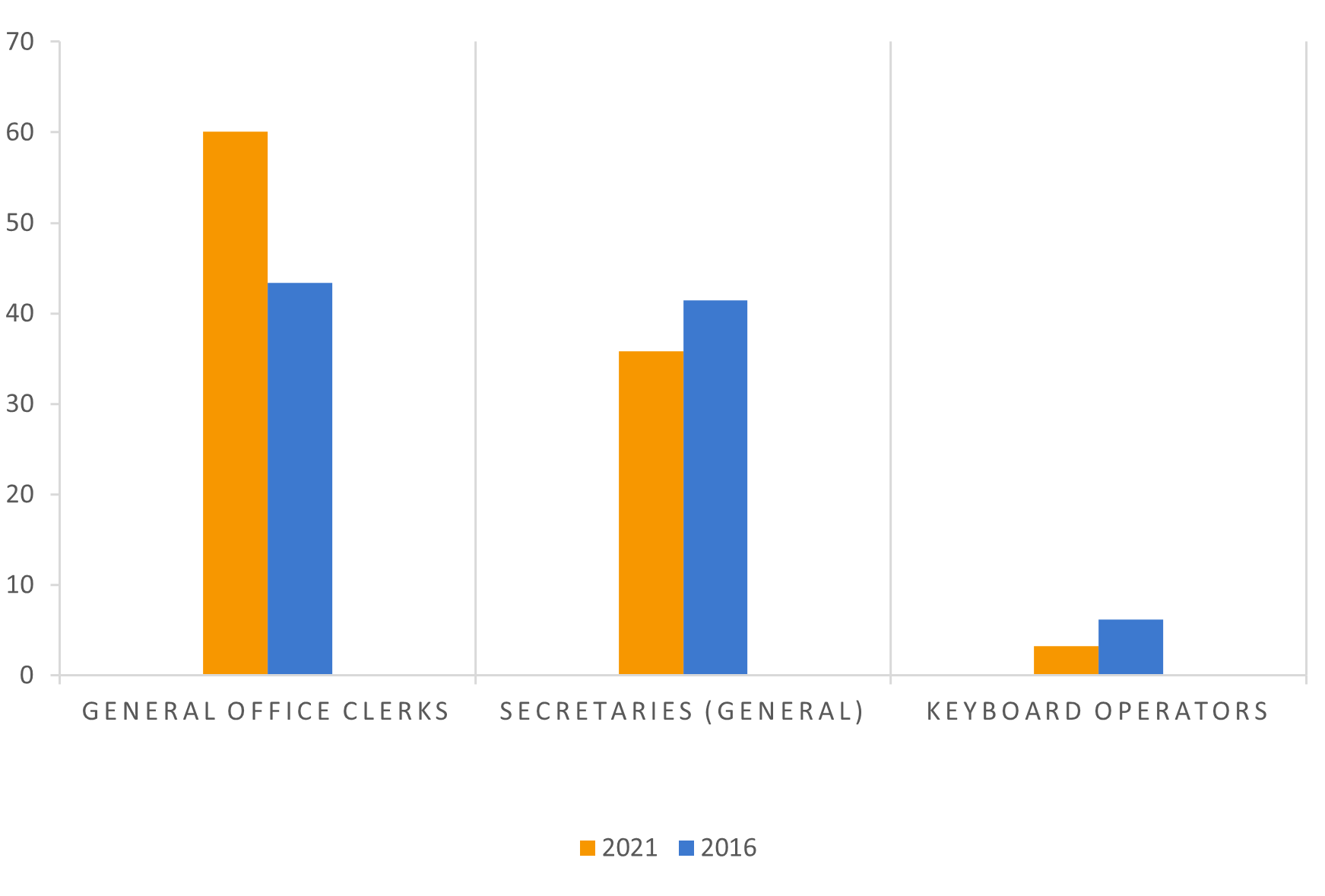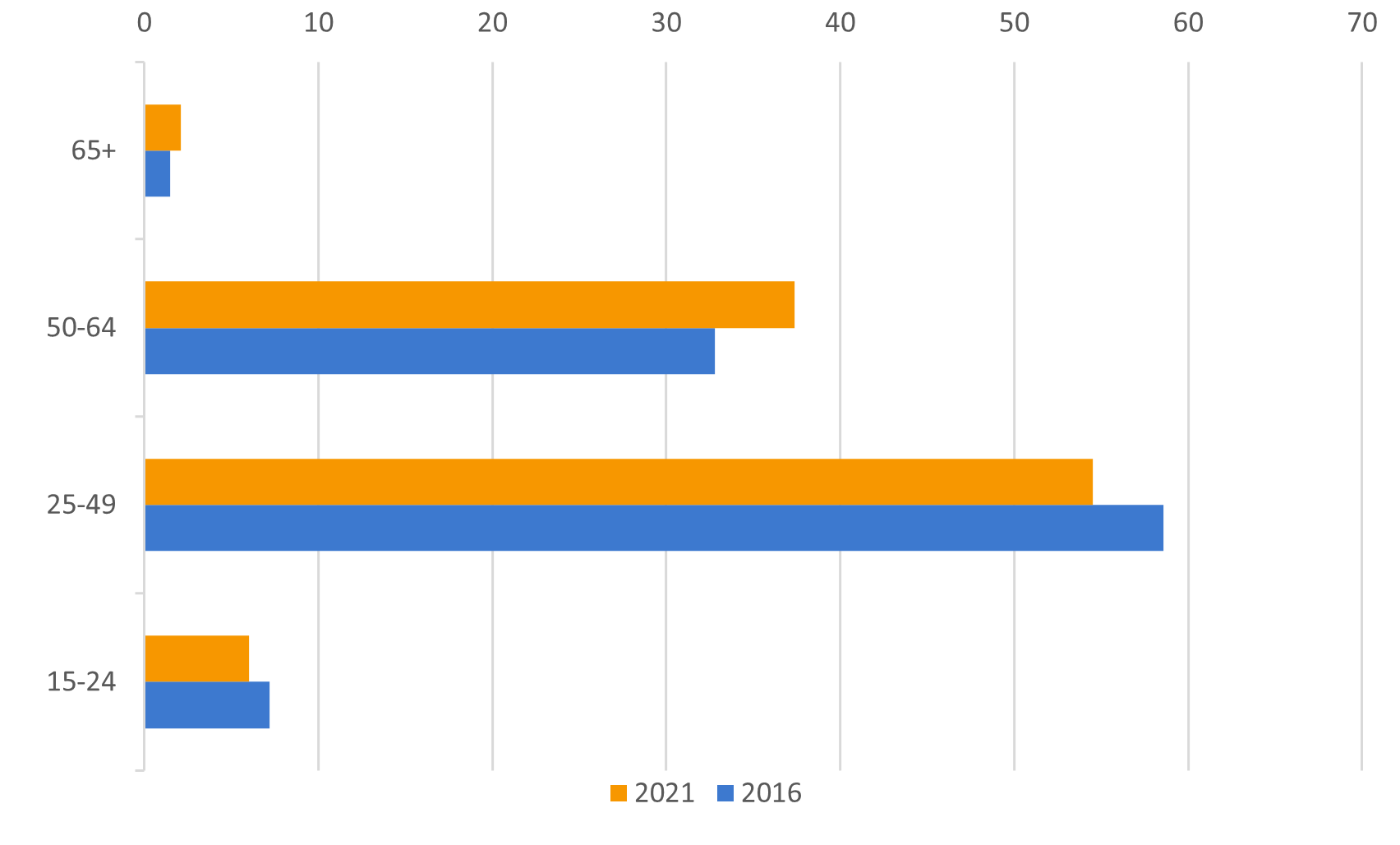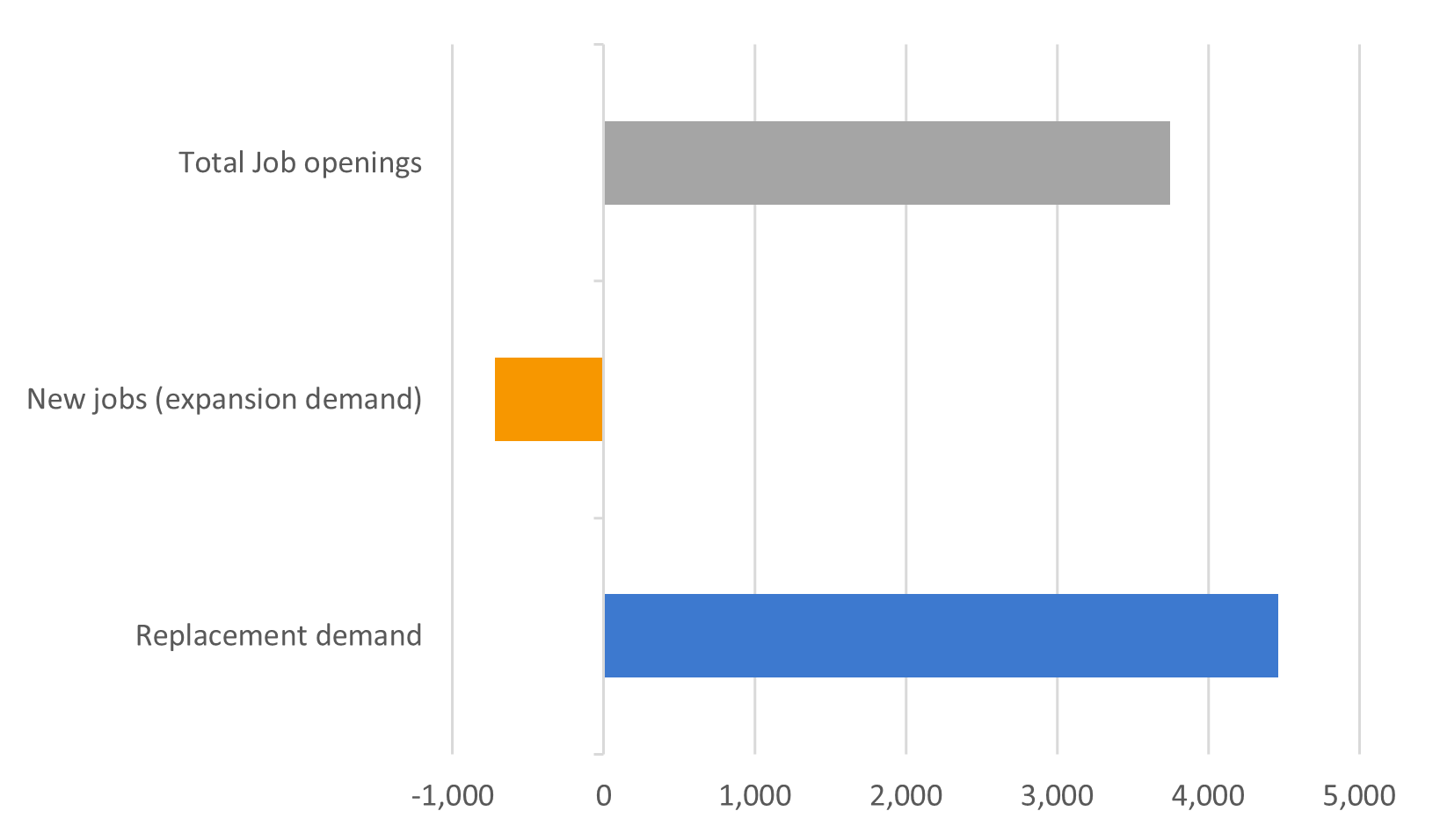You are here
- Home
- Publications and reports
- Data insights
- Office clerks: skills opportunities and challenges (2023 update)
Office clerks: skills opportunities and challenges (2023 update)
Summary
Office clerks (or clerical support workers as they referred to in the International Standard Classification of Occupations, ISCO) record, organise, compute, and retrieve information, and perform a number of clerical duties in connection with money-handling operations, travel arrangements, requests for information, and appointments. Specific office clerk jobs include, amongst others, secretaries, proofreaders, data entry clerks, typists, and word-processing operators. These jobs are spread across a wide range of sectors.
Key facts
- Around 8.5 million people were employed as office clerks in 2022, accounting for more than 4 per cent of total EU employment.
- Between 2012 and 2022, employment in the occupation increased by almost 50 per cent. Over the same period, employment across all occupations in the EU increased by just 8 per cent.
- Before the pandemic, office clerk employment increased by 754 thousand workers between 2012 and 2019. Between 2019 and 2022, despite the economic lockdowns experienced across the EU, office clerk jobs increased by 2 million workers.
- Many office clerks (46 per cent in 2021) were employed in the public administration, manufacturing, and wholesale and retail sectors.
- In 2021, nearly two thirds of office clerks had attained a qualification level at ISCED 3 or 4, equivalent to the education level achieved after completing upper secondary education. The qualification level of the occupation is forecasted to change over the period to 2035, with more workers attaining high-level qualifications.
- The employment of office clerks is projected to slightly decline between 2022 and 2035.
- By 2035, employment in the occupation is poised to decline by more than 700 thousand jobs. Although there will be a fall in the overall number of people as office clerks, there will be a large number of office clerk jobs to be filled over the same period. This is because an estimated 4.5 million people are expected to leave the occupation mainly due to retirement. This means that an estimated 3.8 million job openings will need to be filled between 2022 and 2035.
- Technological change is the main driver of change in the skills required of office clerks. This includes digitalisation, which is likely to have an impact on the tasks office clerks are expected to fulfill.
Employment and job demand
Employment trends for office clerks were higher than all clerical support workers in the past decade. Extreme growths took place during the Covid-19 pandemic, but that growth immediately declined the following years. Overall, employment levels are higher than before the crisis.
Figure 1: Year-to-year employment change for office clerks (2013-2022)

Source: European Labour Force Survey. Employed persons by detailed occupation (ISCO-08 two-digit level) [LFSA_EGAI2D__custom_7778289]. Own calculations.
About two thirds (60 per cent) of office clerks are employed as general office clerks. These follow established procedures to perform various clerical and administrative tasks such as recording, classifying and filing information, preparing reports and correspondence of a routine nature, responding to telephone or electronic inquiries or forwarding to appropriate persons, transcribing information onto computers, as well as proofreading and correcting documents.
About a third (35 per cent) of office clerks are engaged as secretaries. People employed in these jobs use machines such as typewriters, personal computers, or other word-processing equipment to transcribe correspondence and other documents, and check and format documents prepared by other staff. They also engage in providing administrative support and organizing and supervising filing systems using various computer software packages such as spreadsheets.
Only 3 per cent of office clerks are engaged as keyboard operators who use software packages to input and process text and data and prepare, edit and generate documents for storage, processing, publication and transmission.
Over time the share of employment for the first occupation mentioned above increased, while the other two faced drops.
Figure 2: Employment in Office clerk jobs (in %)

Source: European Labour Force Survey. Microdata. Own calculations.
In the OJAs, general office clerks and secretaries are more frequently requested than keyboard operators. Lower job demand for the latter is an impact of their responsibilities being redistributed to the other two occupations.
For more details on skills demand and job openings for this occupation, please access the Cedefop’s Skills OVATE tool.
Figure 3: Online job advertisements for office clerks (2022, in %)

Source: Skills in Online Job Advertisements indicator based on Cedefop’s Skills OVATE. Own calculations.
Note: Online job advertisements are by definition not equivalent to job vacancies. See Beręsewicz (2021) or Napierala et al. (2022).
A substantial share of office clerks (46 per cent in 2021) is employed in the public administration and defence (22 per cent), Manufacturing (12 per cent), and Wholesale and Retail trade sectors (almost 12 per cent). Over time, the share of employment between those sectors has not changed markedly.
Figure 4: The top sectors employing office clerks (in %)

Source: European Labour Force Survey. Microdata. Own calculations.
The share of employment in this occupation is the highest in Italy, Greece and Belgium.
Figure 5: Office clerks as a share of overall country employment (2021, in %)

Source: European Labour Force Survey. Microdata. Own calculations.
Note: Data for CY, EE, IS, LV and LU have lower reliability because of the small sample size. LFS data for MT are not available.
The workforce is comprised largely of women (79 per cent in 2021).
Office clerks are, compared with the labour force as a whole, relatively old. In 2021, 37 per cent of office clerks were aged between 50 and 64 years compared with 28 per cent across all occupations.
Figure 6: Office clerks workforce by age (in %)

Source: European Labour Force Survey. Microdata. Own calculations.
The percentage of office clerks employed on part-time contracts was markedly higher than the average across all occupations. Involuntary part-time employment is much less widespread amongst office clerks than across all occupations.
Figure 7: Contract and hiring trends for office clerks (in %)

Source: European Labour Force Survey. Microdata. Own calculations.
Skill needs and future trends
Office clerks follow established and standard procedures to perform their tasks. Hence, innovative, and interpersonal skills are not as necessary compared to all occupations average. Even less needed are manual tasks. However, they use digital devices and various software to perform their jobs, so digital skills are important. That is reflected in training needs as well, with digital upskilling being in high demand while overall skills are not so much.
Figure 8: Skills, training needs and job perception of office clerks (in %)

Source: European Skills and Jobs Survey. Microdata. Own calculations.
Unless stated otherwise, it is a share of people reporting that a task/skill is part of their job.
*Always or often
** Share of workers reporting these needs to a great or moderate extent.
Employment for office clerks is forecast to slightly decline over the period 2022 to 2035. This means that, compared with 2022, there will be about 720 thousand fewer office clerk jobs.
Employment declines are forecast for most of the EU countries. However, future employment changes will vary by country. Office clerk employment in eight countries grew over the past decade and it is forecast to do so in the next decade as well. Latvia, Romania, and Cyprus are among those with the highest past and expected future growths, while Finland and the Netherlands represent the opposite trend.
Figure 9: Past and expected future employment trend of office clerks

Source: European Labour Force Survey. Microdata. Cedefop Skills Forecast.
Note: Data for CY, EE, IS, LV and LU have lower reliability because of the small sample size. LFS data for MT are not available.
The forecasted employment does not mean there are not going to be many job opportunities. Most job openings are a result of people leaving them for other opportunities, or those leaving the labour market completely (e.g. retirement). For office clerks, replacement demand is substantial at 4.5 million.
Overall, when future job destruction is added to replacement demand, an estimated 3.8 million job openings for office clerks will need to be filled between 2022 and 2035.
Figure 10: Future job openings for office clerks (000s)

Source: Future job openings indicator based on the Cedefop Skills forecast. Own calculations.
About 61 per cent of office clerks held medium-level qualifications in 2021 (i.e. at ISCED levels 3 or 4). This is projected to change slightly by 2035. The share of workers with medium levels of qualification is projected to fall to 56 per cent, while the share of highly qualified workers (i.e. those qualified at ISCED level 5 and over) is projected to increase to 38 per cent.
Looking forward
The skills required for office clerks have changed considerably in recent years due to technological change and globalisation. A recent Cedefop and Eurofound report noted that these megatrends, along with workforce ageing, are gradually causing a “hollowing out” in the middle of EU occupational distribution. People working in middle-skilled occupations such as office clerks need to adapt to the continuous reshaping of the tasks they are required to carry out.
Digitalisation affects office clerks in multiple ways, including through the automation of routine tasks that require low-level skills. Labour market demand for high-cognitive skills (written and oral expression, reasoning and complex problem solving) has increased over the past decade. (OECD Skills Strategy, 2019). Job positions involving secretarial skills have evolved in such a way that today many secretarial activities are now conducted by means of ICT tools (Bette et al., 2021). Secretaries, typists, data entry, and personnel clerks are more likely to face changes in the types of tasks they will be expected to carry out rather than being replaced by automation (see box below). It is estimated that 5 per cent of office clerks in the EU are at a high risk of their jobs being substituted by automation (Cedefop 2020 ‘Automation risk for occupations’). Office clerks will require strong literacy and ICT skills to be able to gather and evaluate information to adapt to constantly developing digital tools, as well as social skills and problem-solving competences in teamwork to adapt to digital changes.
|
“Data clerks do interact with digital technologies, but they do so in a routine-based and sometimes repetitive manner. Among the tasks of data entry clerk there is the transferring of data from paper formats into computer files or database systems. Data entry clerks do usually type in data provided directly from customers and create spreadsheets with large numbers of figures. (…) As new technologies start to automatise some of these tasks, jobs for data entry clerks may either decline in volume or radically change the nature of some of the tasks that are currently carried out by those employed in these occupations.” Source: OECD (2022). |
Globalisation has an impact on the distribution of office clerks across EU countries rather than their overall employment levels. As industries and companies are increasingly embedded in global value chains, some clerical office jobs and tasks will be outsourced outside of Europe. In a similar fashion to the risk of automation, the tasks and jobs most susceptible to offshoring are routine in nature and require digital literacy. Increasingly, high-skilled clerical jobs are exposed to offshoring (OECD Skills Strategy 2019). Some clerical jobs, such as middle-skilled back-office services (i.e., administrative, HR, but also IT and accounting) have also been affected by nearshoring (that is, moving from Western to Eastern Europe (Brunello and Wruuck, 2021). In addition, increased interaction with offshore companies in global value chains, cross-border transactions and different legal structures and regulatory processes pose challenges for every firm. Corporate secretarial services involve workers skilled in international communication and processes and facilitate cross-border activity.
Replacement demand is likely to be a key source of job opportunities in OECD countries in the coming decade (OECD Skills Strategy 2019). To accommodate the necessary productivity increases that will balance future employment decline, further investment in continuous training is needed to equip office clerks with digital skills, awareness of international business and related skills to assist firms in cross-border activity.
The emergence of the COVID-19 pandemic has highlighted the importance of digital skills even more. According to latest Cedefop research, knowledge of digital skills allowed workers in many occupations, including clerical workers, to shift to remote working “basically overnight”. Prior to the pandemic about 10 per cent of general keyboard clerks and other clerical support workers had experienced some form of telework (European Commission). As remote work becomes more frequent in the years ahead, office clerks will need to acquire advanced digital skills to adapt to a new hybrid form of working. According to recent research (Bette et al., 2021) secretarial skills expected to be in higher demand post-pandemic include digital competences (such as knowledge of operating of video conferencing platforms, online agendas, and software management), and behavioural skills such as self-organisation and management of one’s flow of activities.
The majority of office clerks begin their work life with vocational qualification at ISCED levels 3 and 4. According to Cedefop in 2019 and 2020 57 per cent of office clerks aged 15-34 reported possession of a vocational qualification. Both initial vocational education and training (IVET) and continuing vocational education and training (CVET) schemes and programmes (such as apprenticeships) can help to train new office clerks and upskill workers currently in the labour market to adapt to a digitalised future office.
As regards IVET, there is a need to update training programmes to include much demanded digital skills. In addition, apprenticeships can be an important means for young clerks to get to know the workplace and its requirements. Apprenticeships can prove to be quite helpful in environments where upskilling needs are large, and time is scarce (McKinsey, 2021). Research demonstrating the ability of apprenticeships to equip people with the skills required in the labour market is now substantial (cf. Cedefop’s research on the effective delivery of apprenticeships). The European Alliance for Apprenticeships provides support to countries and sectors looking to improve and expand the provision of apprenticeships.
Provision of short-courses, and particularly those provided online, is a means for office clerks to adapt quickly to the changing nature of the post-pandemic, digitalised, and more internationalised office administration. It is important that such courses provide an externally certificated qualification. Micro-credentials can fulfil a role here. These are short learning activities provided to meet a variety of needs, such as specific professional development needs, ad hoc needs to close skills gaps and update skills, and internal company training and career development (Cedefop). The European Commission recognises them as a flexible and targeted way to help people develop the knowledge, skills and competences they need for their personal and professional development.
Examples of such online sources include short training for corporate secretaries, secretaries of directory boards, basic office skills, as well as training in laboratories to acquire digital skills (including the Blind Typing System that allows typing without viewing the keyboard).
In addition, language skills are important for maintaining everyday office business in an international environment. Initiatives such as the ‘Language at work’ in Netherlands (Cedefop, 2020) provides an example of language skills for office clerks can be delivered. In this initiative, employers agreed to improve the language skills of their employees and received a subsidy to provide language courses at or outside the workplace.
How to cite this publication:
Cedefop (2023). Office clerks: skills opportunities and challenges. Skills intelligence data insight.
Further reading
Beręsewicz, M. and Pater, R. (2021). Inferring job vacancies from online job advertisements, Luxembourg: Publications Office, 2021. https://ec.europa.eu/eurostat/web/products-statistical-working-papers/-/ks-tc-20-008
Bette, T. R., Zuin, D. C., Baêta, O. V., & Moreira, N. C. (2021). Secretarial work in pandemic times: new skills or old tasks?. Revista De Gestão E Secretariado (Management and Administrative Professional Review), 12, 111–135. https://doi.org/10.7769/gesec.v12i3.1241
Brunello, G. & Wruuck, P. (2021). Skill shortages and skill mismatch: a review of the literature. Journal of Economic Surveys, 35, 1147-1167, https://onlinelibrary.wiley.com/doi/abs/10.1111/joes.12424
Cedefop (2020). Empowering adults through upskilling and reskilling pathways. Volume 2: Cedefop analytical framework for developing coordinated and coherent approaches to upskilling pathways for low-skilled adults. Luxembourg: Publications Office of the European Union. Cedefop reference series; No 113. http://data.europa.eu/doi/10.2801/61322
Cedefop (2021). Digital skills: Challenges and opportunities. Skills intelligence data insight. 22 February 2021.
Cedefop (2022). Microcredentials for labour market education and training. https://www.cedefop.europa.eu/en/publications/5587
Cedefop (2023). Skills in transition: the way to 2035. Luxembourg: Publications Office. http://data.europa.eu/doi/10.2801/438491
European Commission (2020). Telework in the EU before and after the COVID-19: where we were, where we head to. Science for Policy Brief. Accessed 12 January 2023.
European Commission (2021). A European approach to micro-credentials, Accessed 6 January 2023.
European Labour Authority (2021). Report on labour shortages and surpluses.
McKinsey (2021). Reviving the art of apprenticeship to unlock continuous skill development. 21 October 2021.
Napierala, J.; Kvetan, V. and Branka, J. (2022). Assessing the representativeness of online job advertisements. Luxembourg: Publications Office. Cedefop working paper, No 17. http://data.europa.eu/doi/10.2801/807500
OECD (2019). Skills Strategy, https://www.oecd.org/skills/oecd-skills-strategy-2019-9789264313835-en.htm, Accessed 6 January 2023
OECD (2022). Skills for the Digital Transition: Assessing Recent Trends Using Big Data, Paris: OECD Publishing, https://www.oecd.org/employment/skills-for-the-digital-transition-38c36777-en.htm
Data insights details
Table of contents
Page 1
SummaryPage 2
Employment and job demandPage 3
Skill needs and future trendsPage 4
Looking forwardPage 5
Further reading
